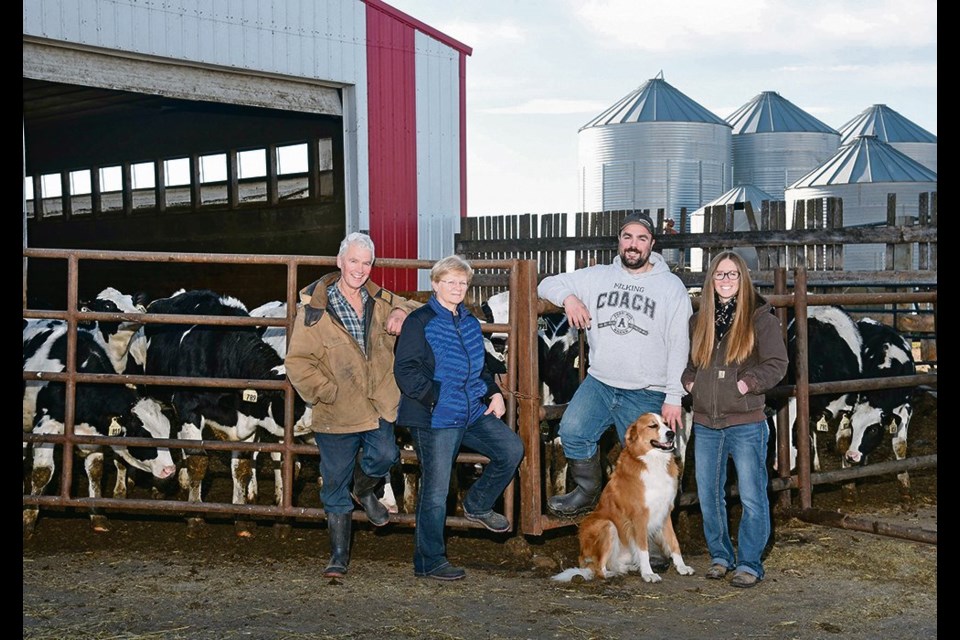BIRCH HILLS, SASK. — Erin Kernaleguen grew up in Calgary and has long yearned to travel — 29 countries so far.
But marrying a dairy farmer has altered the city gal’s perspective.
“The objective to travel is never gone, it’s just changed. I don’t have the desire to go for six months or a year anymore. But we try to go on some trips, even if it’s just to Texas to visit friends. Often it involves dairy or ranching, which is OK,” she said.
Added husband Paul with a laugh: “The joke is dairy farmers leave to go visit other dairy farmers.”
They look forward to an educational trip to Iceland to learn about the dairy system there.
The 30-something couple farm with Paul’s parents, Brenda and Joe Kernaleguen, at JBK Farms near Birch Hills, Sask. Together, the four milk about 100 cows on their 540 acre base.
For years, regenerative agriculture has played an important role for them, improving soils by building the land’s organic matter and sequestering carbon.
“It’s a completely different transition from chemical-minded farming to more of a biology-minded farming,” said Paul.
The family also operates one of the few remaining closed dairy herds in the province, in which they do all artificial insemination themselves.
“We’ve never bought animals to bring in. We calve our animals out and we raise our calves ourselves.”
“The beauty of having a closed herd is you have a lot of control over its health, over the genetics,” said Brenda.
Added Joe: “Probably the 1960s was the last time we bought cattle. We don’t have many diseases. We know the diseases we’ve got and we’re not buying new diseases (at sale).”
Brenda and Joe bought the existing farm in 2010 from a dairy farmer who had operated a much larger herd and barn.
The extra space has worked out well for their retail beef business aptly named Brenda’s Blue Ribbon Beef.
“We have half the barn dedicated to the dairy animals and dry cows and the other half dedicated to the young stock and beef animals because we sell beef off the farm too,” said Brenda.
“The barn is so big we’re able to keep all the male Holsteins inside, so they get fed just like a regular feedlot-type style,” said Paul.
Added Erin: “Because we’re a dairy, we calve all year. We have a constant supply coming in because we’re calving sometimes every day so we’re able to keep up demand. We have very consistent outcomes in our beef quality, so we now know what we’re expecting from our animals based on our feed program.”
For the past five years, Brenda’s Blue Ribbon Beef has been a popular staple at the Prince Albert Farmers Market, which has increased their on-farm sales and provided a loyal following of customers.
Marbling is one of the main characteristics that buyers are looking for, which she said comes naturally to Holsteins.
In fact, customers and a few local butchers have compared the texture and quality of their product to Wagyu beef, a Japanese breed of beef cattle, which is among the most sought-after and expensive meats in the world.
“Customers think that the steaks they’re already getting from us off of the Holstein animals is equivalent to the Wagyu,” said Brenda.
“The difference of the Holstein steer and the Wagyu steer at 15 to 16 months was negligible. It’s pretty similar unless you are going to go grow that Wagyu out to a more advanced age of three years,” she said.
Business for Brenda’s Blue Ribbon Beef has not slowed because of COVID-19. It’s only got busier.
As packing plants slowed or even closed for extended periods, Brenda reached out to customers letting them know she was still available to fill orders.
She credits the foresight of their local butcher who urged them to advertise soon after COVID started.
“He said, ‘people are going to be looking for places to buy. Put a sign out on the highway, you’ve got the perfect location. So Paul built the sign and put it by the road,” she said.
“When the slaughter plants were shutting down in Alberta and there was not as much meat available in stores people were looking for places to buy locally and so people started buying from us. Once they realized the difference in the taste and quality then sales increased quite a bit,” she added.
While more customers are welcomed, meeting supply and demand has become a growing pain as the number of cattle in the home corrals has increased.
“We’re behind right now. We’ve got animals standing out there that are sold and the butcher is trying to catch up,” Brenda said.
“We kept the price list the same for the last four years. We just wanted people to know that good quality meat was available, affordable, and they could trust us to give them a good product.”
Added Paul: “We didn’t raise our prices all through COVID because our costs are still the same. But now commodities are just going higher and higher.”




